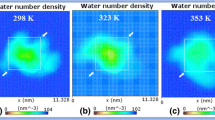Abstract
A general theory of the drying of frozen tissue is developed and applied to the measurement of the drying rate of frozen guinea pig liver. It is shown that for a given temperature of the subliming ice crystals the mininum drying time of a piece of guinea pig liver is greater than the minimum sublimation time of a piece of ice of the same size and shape by a factor of the order of one thousand. This fact has many implications in the design of freeze-dry apparatus which will be developed in a following paper.
Similar content being viewed by others
Literature
Carman, P. C. 1948. “Molecular Distillation and Sublimation.”Trans. Far. Soc.,44, 529–36.
Carslaw, H. S. and J. C. Jaeger. 1947.Conduction of Heat in Solids. London: Oxford University Press.
Ede, A. J. 1949. “Physics of the Low-Temperature Vacuum Drying Process.”Jour. Soc. Chem. Ind.,68, 340–32.
—. 1949. “The Low-Temperature Vacuum Drying Process as Applied to Green Peas.”Ibid.,68, 336–40.
Flosdorf, E. W. 1949Freeze-Drying. New York: Reinhold Publ. Corp.
Gersh, I. 1932. “The Altman Technique for Fixation by Drying While Freezing.”Anat. Rec.,53, 309–37.
Greaves, R. I. N. 1946. “The Preservation of Proteins by Drying, with Special Reference to the Production of Dried Human Serum and Plasma for Transfusion.”Medical Research Council. Special Report Series. #258.
— and M. E. Adair. 1939. “High-Vacuum Condensation Drying of Proteins from the Frozen State.”Jour. Hyg.,39, 413–45.
Kennard, E. H. 1938.Kinetic Theory of Gases. New York: McGraw-Hill Book Co.
Kramers, H. and S. Stemerding. 1951. “The Sublimation of Ice in Vacuum.”App. Sci. Res.,3, 73–82.
Malmstrom, B. G. “Theoretical Considerations of the Rate of Dehydration by Histological Freezing-Drying.”Exp. Cell. Res.,2, 688–92.
Packer, D. M. and G. H. Scott. 1942. “A Cryostat of New Design for Low Temperature Tissue Dehydration.”Jour. Tech. Methods,22, 85–96.
Scott, G. H. and N. L. Hoerr. 1950. “Drying: Frozen-Dehydration Method for Histologic Fixation.” 292–96.Medical Physics. Sec. Ed., Chicago: The Year Book Publishers.
Sjöstrand, F. 1951. “Freeze-Drying of Tissues for Cell Analysis by Light and Electron Microscopy.” 177–88.Freezing and Drying. (Ed. R. J. C. Harris.) Institute of Biology: Travistock House South, London.
Zamzov, W. H. and W. R. Marshall, Jr. 1952. “Freeze Drying with Radiant Energy.”Chem. Eng. Progress,48, 21–32.
Author information
Authors and Affiliations
Additional information
Aided by a grant from the Wallace C. and Clara A. Abbott Memorial Fund of the University of Chicago and from the Commonwealth Fund of New York.
Rights and permissions
About this article
Cite this article
Stephenson, J.L. Theory of the vacuum drying of frozen tissues. Bulletin of Mathematical Biophysics 15, 411–429 (1953). https://doi.org/10.1007/BF02476434
Received:
Issue Date:
DOI: https://doi.org/10.1007/BF02476434




